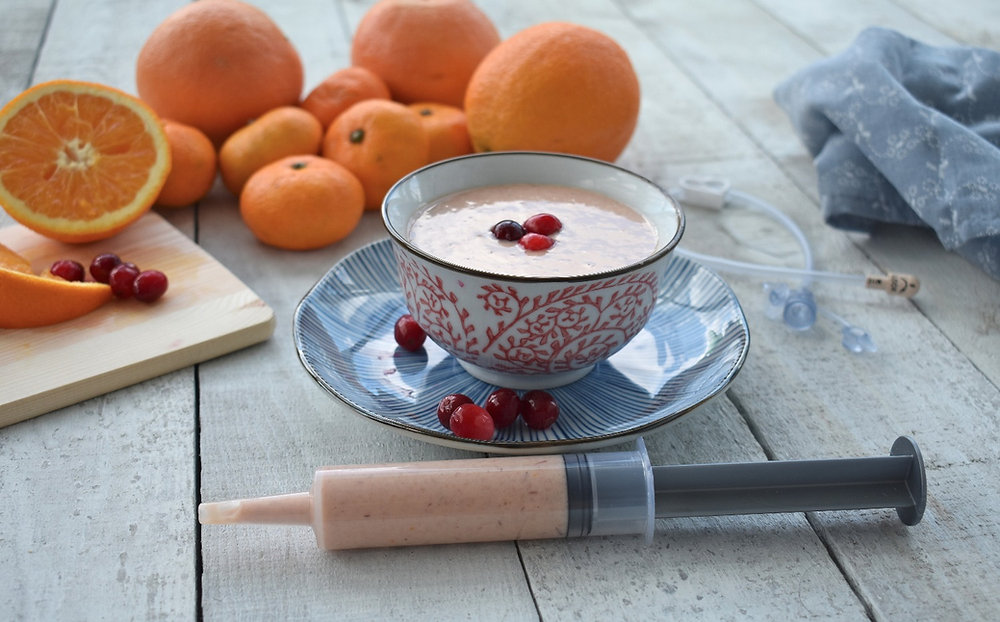- Contact:
- +971 4 26 68 222
- +971 50 3860 777

Blenderized tube feeding is becoming popular as more families search for natural and whole-food choices instead of formula. Many caregivers and patients feel that real food improves comfort, health, and overall quality of life. This guide explains what blenderized diets are, why people use them, who can benefit, and how to prepare them safely.
Blenderized diets are meals prepared by blending real foods into a smooth liquid that can pass through a feeding tube. These blends are designed to provide complete nutrition, similar to what someone would eat if they were able to consume food orally.
Traditional tube feeding often relies on commercial formulas, which are pre-made balanced liquid products that include proteins, carbohydrates, fats, vitamins, and minerals. While convenient, some families prefer real food tube feeds because they align with cultural, nutritional, and personal values.
With a high-powered blender, caregivers can create homemade tube feeding recipes from whole foods such as vegetables, fruits, grains, dairy, and meats. These blends allow meals to be customized to calorie and nutrient needs, giving families more control over nutrition.
Blenderized feeding can take different forms depending on patient needs:
Families often choose blenderized diets for both health and emotional reasons. Some patients tolerate real food better, with fewer issues like reflux, constipation, or diarrhea compared to formula. Whole foods also provide natural nutrients such as antioxidants, fiber, and phytonutrients that standard formulas may not fully cover.
Beyond physical health, blenderized tube feeding can bring a sense of normalcy for families. Preparing and sharing the same foods, even if delivered differently, allows caregivers to feel more involved and patients to feel included in mealtime routines. This connection can make care more personal and meaningful.
Blenderized tube feeding is not suitable for everyone, which is why professional guidance is important.
Good candidates may include:
Extra caution is needed when:
Healthcare professionals such as dietitians and gastroenterologists play a vital role in evaluating whether blenderized diets are appropriate.
Transitioning to blenderized diets should be gradual and supervised.
Steps to follow:
Measuring calories and protein is essential to maintain balance. A consistent feeding schedule and recipe adjustments based on individual needs help ensure long-term success.
A well-planned recipe should provide all essential nutrients:
Equipment such as high-powered blenders (e.g., Vitamix, Blendtec), strainers, and syringes or gravity bags are often needed to make safe, smooth blends.
Food safety is critical to prevent infection and tube blockages.
Blenderized diets have many benefits, but challenges exist:
Solutions include using a strong blender, following strict hygiene practices, adding supplements as recommended, and keeping a food and symptom diary. When managed carefully, these risks can be minimized.
An at-home nurse can make tube feeding safer and less overwhelming. Nurses help with tube care, cleaning, and monitoring for complications. They guide caregivers on safe food preparation and feeding techniques. Beyond clinical support, nurses provide reassurance and emotional support, giving families confidence in managing daily care.
Blenderized diets for tube feeding offer a natural, real-food alternative to formula. Many patients and families notice better tolerance, improved digestion, and enhanced quality of life when this approach is introduced carefully. At the same time, risks such as tube clogging and contamination require serious attention. With proper guidance from doctors, dietitians, and skilled nurses, blenderized diets can be both safe and rewarding. For families considering this path, moving step by step with professional support is the best way to ensure lasting success.
Skilled Nursing Support for Safe Blenderized Tube Feeding at Home
Eureka Home Healthcare offers DHA-licensed skilled nurses who are experienced in managing blenderized tube feeding at home. Our team ensures safe preparation, smooth administration, and continuous monitoring to support both comfort and nutrition. With compassionate care and affordable services, families can confidently rely on our nurses to deliver professional tube feeding support in the comfort of their homes.
Can any patient use blenderized diets for tube feeding?
Not all patients can. Suitability depends on tube type, digestion, and overall health.Always check with a doctor or dietitian.
How do you prevent tube clogging with blenderized food?
Use a high-powered blender, strain recipes well, and flush the tube with water before and after feeds.
Are commercial blends better than homemade ones?
Commercial blends offer convenience and consistent nutrition, while homemade blends allow personalization. Both can be safe when prepared and used properly.
How many calories should a blenderized tube feeding provide daily?
This depends on age, weight, and medical needs. A dietitian can calculate the right amount.
What foods should be avoided?
Foods with tough skins, seeds, or high fiber (like popcorn, nuts, and raw fibrous vegetables) may clog the tube and should be avoided.
Is blenderized tube feeding covered by insurance?
Some insurance policies cover commercial blends, but homemade ingredients are usually not included. Coverage varies.
Can patients travel while using blenderized diets?
Yes, with preparation. Portable blenders, coolers, or commercial blends can make travel easier.
How do I know if my child is tolerating blenderized feeding?
Good signs include weight gain, stable energy, and no digestive issues. Keep a symptom diary to track progress.
What blender works best?
High-powered blenders such as Vitamix or Blendtec are recommended for smooth, clog-free blends.
How long can blends be stored safely?
Refrigerated blends should be used within 24 hours, and leftovers should be discarded.
In the home setting, Nurses play an integral role in the delivery of quality healthcare services that generates trust and collaboration for both the care of the client and the maintenance of health of other family members as well.
Office 107, Business Point Building, Port Saeed, Dubai, United Arab Emirates
Mob : +971 50 3860 777
Tel : +971 4 26 68 222
© 2023 Copyright Eureka Home Health Care | Patient Rights | All rights reserved.
MOH APPROVAL # 17GKT9GT-040725